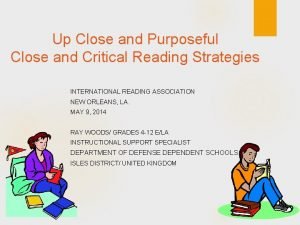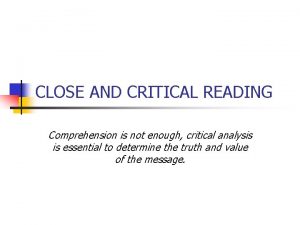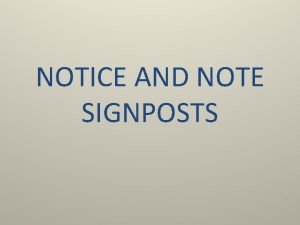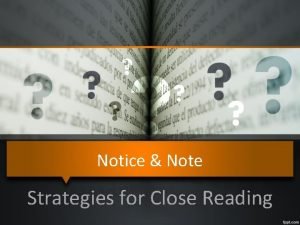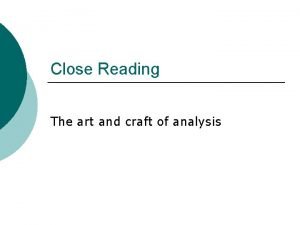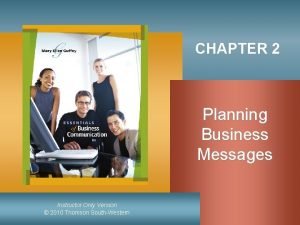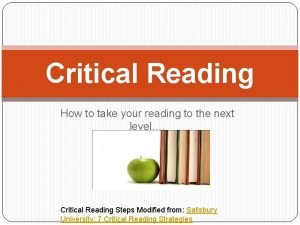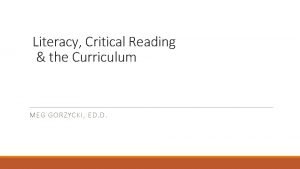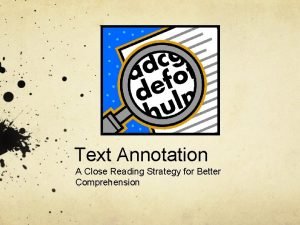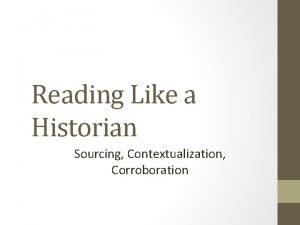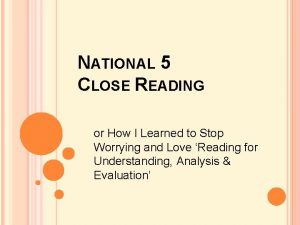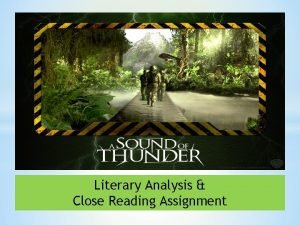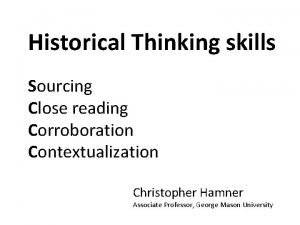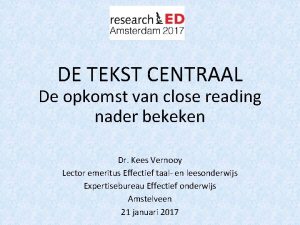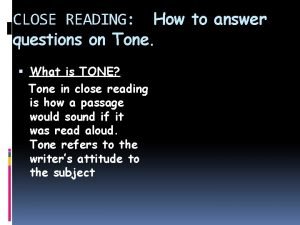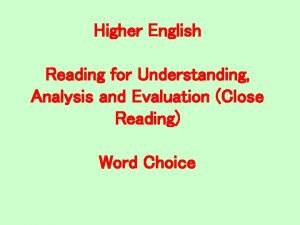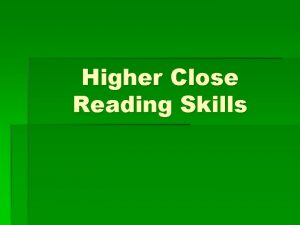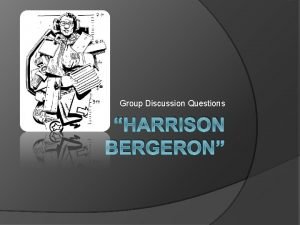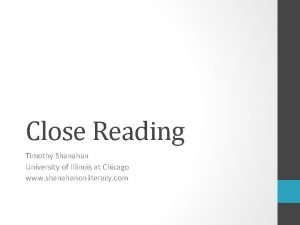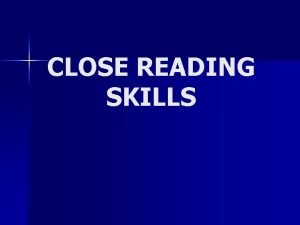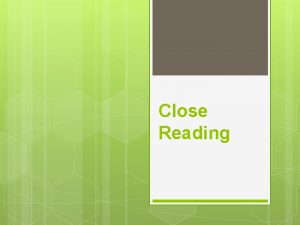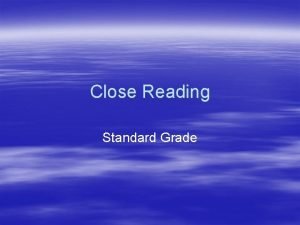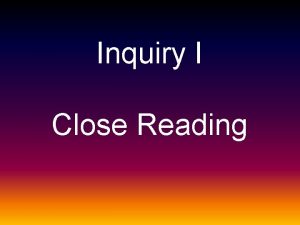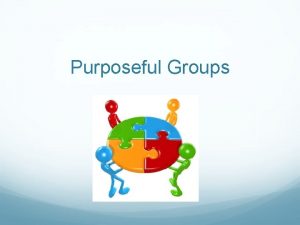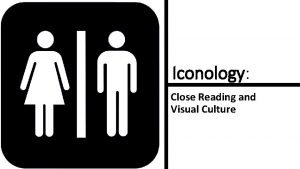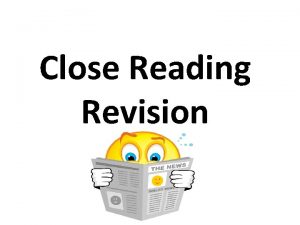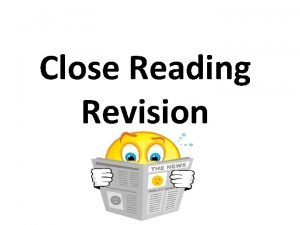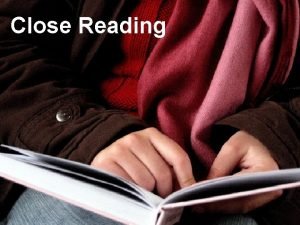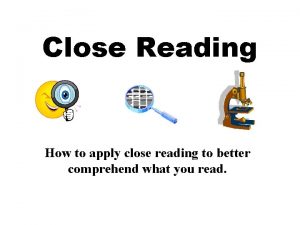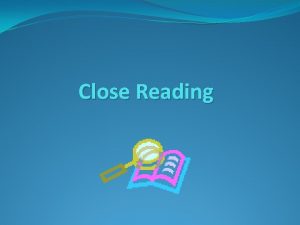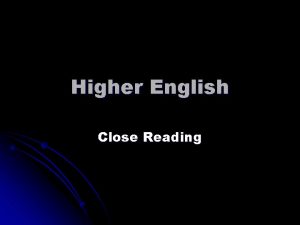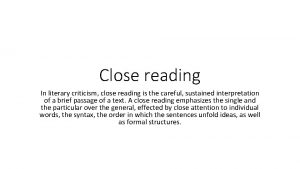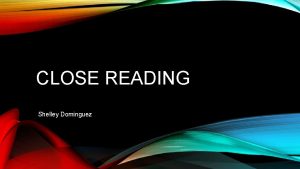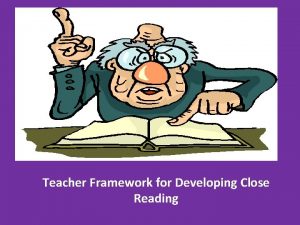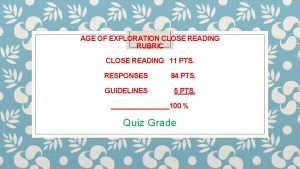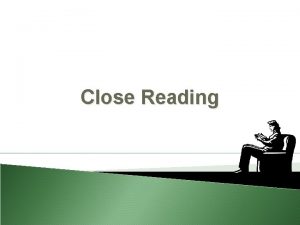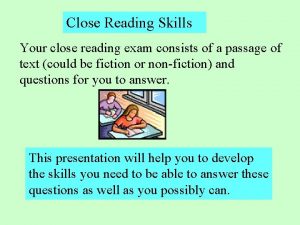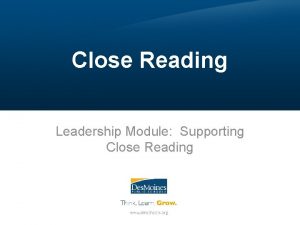Up Close and Purposeful Close and Critical Reading































- Slides: 31

Up Close and Purposeful Close and Critical Reading Strategies INTERNATIONAL READING ASSOCIATION NEW ORLEANS, LA. MAY 9, 2014 RAY WOODS/ GRADES 4 -12 E/LA INSTRUCTIONAL SUPPORT SPECIALIST DEPARTMENT OF DEFENSE DEPENDENT SCHOOLS ISLES DISTRICT/ UNITED KINGDOM

The goals for this session: * Experience close reading strategies * Share resources

Why close reading? A significant body of research links the close reading of complex text—whether the student is a struggling reader or advanced— to significant gains in reading proficiency and finds close reading to be a key component of college and career readiness. (Partnership for Assessment of Readiness for College and Careers, 2011, p. 7)

Overview: • Review of critical reading strategies and the e-portal… • Read like a Detective – A Common Core Close Reading Strategy… • Text Dependent Questions • GHR / A short experience with Guided Highlighted Reading - a close reading strategy for comprehension… http: //4 -12 ela. idso. eportalnow. net/

Close and Critical Reading Framework Four questions. . . 1. What does the text say? OR - What is the content of the text? 2. How does the text say it? OR - What techniques of craft and structure does the author use in the text? 3. What does the text mean? OR - What is theme/thesis of the text and how does the author's choice of content, structure, and craft combine to achieve his/her purpose - author's intent? 4. What does the text mean to me?

“Every book has a skeleton hidden between its covers. Your job as an analytic reader is to find it. ” Adler and Van Doren, 1940/1972

Look at both sides of the paper and read “What Close Readers Do Differently. ”

Use the“Close Reading” Strategies on “Read Like A Detective”, after reading “Safari Park Imposes Dress Code To Stop Visitors Scaring The Animals” The Guardian Tuesday, 24 th September 2013. 1. Read the article to yourself or with a partner. 2. In pairs or individually, use the worksheet to respond to all the questions except the last three. 3. You will have read the article more than one time. 4. Share your responses. 5. Discuss how multiple readings helped you respond to the text.

Text for Read Like A Detective

Text talk… What can you guess about the text from the clues? What details do you notice when you reread the text? What seems most important to share? How do you see this as a useful strategy for close reading?

Using Text-Dependent Questions We expect our students to use evidence from texts • to present careful analyses, • well-defended claims, • and clear information. A central tool to help students develop these skills is textdependent questions: • questions that can only be answered by referring back to the text.

Non Text Dependent In “Casey at the Bat, ” Casey strikes out. Describe a time when you failed at something. What makes Casey’s experiences at bat humorous? In “Letter from a Birmingham Jail, ” Dr. King discusses nonviolent protest. Discuss, in writing, a time when you wanted to fight against something that you felt was unfair. What can you infer from King’s letter about the letter that he received? In “The Gettysburg Address” Lincoln says the nation is dedicated to the proposition that all men are created equal. Why is equality an important value to promote? “The Gettysburg Address” mentions the year 1776. According to Lincoln’s speech, why is this year significant to the events described in the speech?

Types of Text Dependent Questions Using questions to peel back the layers of meaning in a text. Inferential Questions “Right There “ Questions Ask for explicit information drawn from the text itself: Solicit conclusions that stem from evidence within the text but not explicitly stated: Organizing Questions Text Structure Questions Look at how the text and its component parts are arranged: Academic Vocabulary and Key Phrase Questions Focus on how specific word choices contribute to the meaning of the text: Clarification Questions Examine the text and sort information based on relevant criteria: Sequence Questions Identify and analyze the steps in an explanation or argument: Purpose Questions Ask for further explanation of particular portions of the text: Investigate the text’s function and deeper meaning: Paraphrasing Questions Request condensed summaries of particular passages: Developed by David Pook (dopook@gmail. com)

Developing Text-Dependent Questions 1. Read one of the two selections. For Middle Level the selection is: Steinbeck, John. Travels with Charley: In Search of America. New York: Penguin, 1997. (1962) From pages 27– 28 For Secondary the selection is: Hemingway, Ernest. A Farewell to Arms. New York: Scribner, 1995. (1929) 2. Review the types of Questions for Text Dependency. 3. Select 1 type of question that would be appropriate for the text and write a question that reflects the type of question and refers explicitly to the text. 4. Share your questions with those around you.

Reviewing the strategy How would you use this as part of your instruction? How often? With what kinds of text? Would you have your students write their own questions?

Guided Highlighted Reading • Reading the text • Responding to prompts as part of multiple readings of the text • Marking the text with highlighters • Checking responses • Summarizing • Assessment

“The Quilt of A Country” Anna Quindlen Newsweek 27/09/2001 1. You’ll need three highlighters – different colors. 2. Read the text carefully. 3. Prompts will be read to you and you will highlight text that respond to the prompts. If a word or phrase has already been highlighted, then use the other colored highlighter to underline what has already been highlighted. 4. After both sets of prompts have been read, and responses have been checked, you will write a 1 -4 sentence summary of what the text says to you. 5. Share your summary with your table. 6. We will then use third marker for author’s craft prompts. 7. You will take a short quiz.

From: “A Quilt of a Country” Anna Quindlen, Newsweek 2001/09/27 1. Tolerance is the word used most often when this kind of coexistence succeeds, but tolerance is a vanilla-pudding word, standing for little more than the allowance of letting others live unremarked and unmolested. 2. Pride seems excessive, given the American willingness to endlessly complain about them, them being whoever is new, different, unknown or currently under suspicion. 3. But patriotism is partly taking pride in this unlikely ability to throw all of us together in a country that across its length and breadth is as different as a dozen countries, and still be able to call it by one name. 4. When photographs of the faces of all those who died in the World Trade Center destruction are assembled in one place, it will be possible to trace in the skin color, the shape of the eyes and the noses, the texture of the hair, a map of the world. 5. These are the representatives of a mongrel nation that somehow, at times like this, has one spirit. 6. Like many improbable ideas, when it actually works, it's a wonder.

“A Quilt of a Country” Prompts for Vocabulary In sentence one, find and highlight the word that means “openmindedness. ” In sentence one, find and highlight the word that means “two or more groups living together. ” In sentence one, find and highlight the word that means “ignored, not spoken about”. In sentence two, find and highlight the word that means “extravagant. ” In sentence two, find and highlight the word that means “distrust. ” In sentence three, find and highlight the word that means “loyalty. ” In sentence five, find and highlight the word that means “crossbreed. ” In sentence six, find and highlight the word that means “unlikely or questionable. ”

From: “A Quilt of a Country” Anna Quindlen, Newsweek 2001/09/27 1. Tolerance is the word used most often when this kind of coexistence succeeds, but tolerance is a vanilla-pudding word, standing for little more than the allowance of letting others live unremarked and unmolested. 2. Pride seems excessive, given the American willingness to endlessly complain about them, them being whoever is new, different, unknown or currently under suspicion. 3. But patriotism is partly taking pride in this unlikely ability to throw all of us together in a country that across its length and breadth is as different as a dozen countries, and still be able to call it by one name. 4. When photographs of the faces of all those who died in the World Trade Center destruction are assembled in one place, it will be possible to trace in the skin color, the shape of the eyes and the noses, the texture of the hair, a map of the world. 5. These are the representatives of a mongrel nation that somehow, at times like this, has one spirit. 6. Like many improbable ideas, when it actually works, it's a wonder.

“A Quilt of a Country” Prompts for Summary In sentence one, find and highlight what tolerance means. In sentence two, find and highlight what “them” is referencing. In sentence three, find and highlight what patriotism is taking pride in. In sentence four, find and highlight who is pictured on the “map of the world. ” In sentence five, find and highlight the kind of nation these people represent. In sentence six, find and highlight when it is “a wonder”.

From: “A Quilt of a Country” Anna Quindlen, Newsweek 2001/09/27 1. Tolerance is the word used most often when this kind of coexistence succeeds, but tolerance is a vanilla-pudding word, standing for little more than the allowance of letting others live unremarked and unmolested. 2. Pride seems excessive, given the American willingness to endlessly complain about them, them being whoever is new, different, unknown or currently under suspicion. 3. But patriotism is partly taking pride in this unlikely ability to throw all of us together in a country that across its length and breadth is as different as a dozen countries, and still be able to call it by one name. 4. When photographs of the faces of all those who died in the World Trade Center destruction are assembled in one place, it will be possible to trace in the skin color, the shape of the eyes and the noses, the texture of the hair, a map of the world. 5. These are the representatives of a mongrel nation that somehow, at times like this, has one spirit. 6. Like many improbable ideas, when it actually works, it's a wonder.

Writing a summary At this point you would have students write a 1 -4 line summary of what they’ve just read and highlighted. If they are working on an on-screen copy, then they can open a word document and construct their summary. When finished you can use the rubric below to score their summaries. Periodically you might have students score their own summaries Standard CCSS Anchor Standards for Reading 3 Complete 2 Partial 1 Minimal 1. Read closely to determine what the text says explicitly and make logical inferences from it: cite textual evidence when writing or speaking to support conclusions drawn from the text. Response • states what the text says explicitly. Response: • includes much of what the text says explicitly. • includes little of what the text says explicitly. • makes logical inferences and cites specific textual evidence to support conclusions drawn from the text. • makes some logical inferences and cites general textual evidence to support some of the conclusions drawn from the text. • makes few logical inferences and gives little support drawn from the text. Score ___/6 points 2. Determine central ideas or themes of a text and analyze their development; summarize the key supporting details and ideas. Response summarizes using: Responses summarizes using: • clearly identified central or main ideas. • supports central ideas well with key details from the text. • partially or ineffectively identified central or main ideas. • supports central ideas with some details and ideas from the text. Reponses summarizes using: • inaccurately identified central or main idea. • supports central ideas with few details and ideas from the text. ___/6 points

“A Quilt of a Country” Prompts for Author’s Craft In sentence one, find and highlight the word choice the author uses for living together peacefully. In sentence one, find and highlight the metaphor the author uses for the word tolerance. In sentence three, find and highlight the partial definition of patriotism. In sentence three, find and highlight what America is compared to in the sentences. In sentence four, find and highlight the imagery used to describe the physical traits of humans. In sentence four, find and highlight in the extended metaphor, what the photographs of the dead placed together would resemble. In sentence six, find and highlight the author’s word choice used to emphasize the mix of nations within one nation. In sentence six, find and highlight the two descriptions of America.

From: “A Quilt of a Country” Anna Quindlen, Newsweek 2001/09/27 1. Tolerance is the word used most often when this kind of coexistence succeeds, but tolerance is a vanilla-pudding word, standing for little more than the allowance of letting others live unremarked and unmolested. 2. Pride seems excessive, given the American willingness to endlessly complain about them, them being whoever is new, different, unknown or currently under suspicion. 3. But patriotism is partly taking pride in this unlikely ability to throw all of us together in a country that across its length and breadth is as different as a dozen countries, and still be able to call it by one name. 4. When photographs of the faces of all those who died in the World Trade Center destruction are assembled in one place, it will be possible to trace in the skin color, the shape of the eyes and the noses, the texture of the hair, a map of the world. 5. These are the representatives of a mongrel nation that somehow, at times like this, has one spirit. 6. Like many improbable ideas, when it actually works, it's a wonder.

Multiple Choice test Choose the best answer for each of the questions. You may review the text you have highlighted. 1. Read the following phrase: ”…standing for little more than the allowance of letting others live unremarked and unmolested. ” What does allowance mean in the phrase above? A. imposed handicap B. taking in to account circumstances C. A regularly provided sum D. the act of permitting 2. Which of the following phrases is an example of a metaphor? A. “…the word used most often when this kind of coexistence succeeds. ” B. “…but tolerance is a vanilla-pudding word” C. “…letting others live unremarked and unmolested” D. “…when it actually works, it’s a wonder. ” 3. Which of the following words does the author use to emphasize the mixture of nations. A. mongrel B. coexistence C. vanilla-pudding D. Allowance 4. Which of the following words does the author use to emphasize the physical traits of humanity? A. imagery B. similes C. metaphors D. Personification 5. What is the primary purpose of the selection? A. To persuade the reader that America is a wonder B. To instruct the reader in American history C. To entertain the reader with humor and word choice D. To inform the reader through analogies and story

Multiple Choice test Choose the best answer for each of the questions. You may review the text you have highlighted. 1. Read the following phrase: ”…standing for little more than the allowance of letting others live unremarked and unmolested. ” What does allowance mean in the phrase above? A. imposed handicap B. taking in to account circumstances C. A regularly provided sum D. the act of permitting 2. Which of the following phrases is an example of a metaphor? A. “…the word used most often when this kind of coexistence succeeds. ” B. “…but tolerance is a vanilla-pudding word” C. “…letting others live unremarked and unmolested” D. “…when it actually works, it’s a wonder. ” 3. Which of the following words does the author use to emphasize the mixture of nations. A. mongrel B. coexistence C. vanilla-pudding D. Allowance 4. Which of the following words does the author use to emphasize the physical traits of humanity? A. imagery B. similes C. metaphors D. Personification 5. What is the primary purpose of the selection? A. To persuade the reader that America is a wonder B. To instruct the reader in American history C. To entertain the reader with humor and word choice D. To inform the reader through analogies and story

Thinking about GHR (Guided Highlighted Reading) • • How does it guide students into the text? In what way are key words and salient points identified? How do the summary and assessment extend the reading? How would text dependent questions be a logical follow-up to the GHR? • In what ways does it offer an expansion for extended conversation about the topic? Questions to consider…. 1. How do you see this strategy being useful for your instructional program? 2. If you teach multiple content areas, such as Social Studies, Science or Math, how would this be useful in helping students read text in those content areas?

Reviewing online resources - the portal http: //4 -12 ela. idso. eportalnow. net/close-reading-and-guidedhighlighted-reading. html Online course work supporting… • Close reading of complex text • Constructing text dependent questions Format / Haiku Class Management https: //my. haikulearning. com/do/account/xauth

Resources: Isles E/LA e-portal link http: //4 -12 ela. idso. eportalnow. net/ Critical Reading and QAR resources portal page http: //4 -12 ela. idso. eportalnow. net/critical-reading-strategies. html Close Reading and Guided Highlighted Reading page with modules for use. http: //4 -12 ela. idso. eportalnow. net/close-reading-and-guided-highlightedreading. html Appendix B/Common Core/text exemplars and sample Performance tasks http: //www. corestandards. org/assets/Appendix_B. pdf

Conclusion: 1. What are the 3 strategies we reviewed for close reading? 2. What online resources are available for you to use? 3. Where are some samples and models of GHR? 4. How can you contact me for any assistance if needed? Many thanks for your time and I hope this has been useful for you.
 Critical semi critical and non critical instruments
Critical semi critical and non critical instruments Semi critical instruments in dentistry
Semi critical instruments in dentistry Close and critical reading
Close and critical reading Close and critical reading
Close and critical reading Active process of discovery
Active process of discovery While reading activities
While reading activities Compare non-critical readers with critical readers.
Compare non-critical readers with critical readers. Notice and note signposts
Notice and note signposts Notice and note strategies
Notice and note strategies The santa ana winds joan didion annotation
The santa ana winds joan didion annotation Active listening is focused and purposeful
Active listening is focused and purposeful The best business writing is purposeful, economical, and
The best business writing is purposeful, economical, and Purposeful listening examples
Purposeful listening examples Don tiburcio de espadaña
Don tiburcio de espadaña Contextualizing in critical reading examples
Contextualizing in critical reading examples Critical reading meaning
Critical reading meaning Annotation symbols for close reading
Annotation symbols for close reading Reading like a historian document a
Reading like a historian document a National 5 close reading
National 5 close reading What is the climax in a sound of thunder
What is the climax in a sound of thunder Sourcing contextualization corroboration close reading
Sourcing contextualization corroboration close reading Close reading teksten groep 4
Close reading teksten groep 4 How to answer a link question
How to answer a link question Close reading definition
Close reading definition Close read answers
Close read answers Close reading objectives
Close reading objectives Close reading a poem
Close reading a poem Higher english close reading
Higher english close reading Higher close reading
Higher close reading Who is the antagonist of harrison bergeron
Who is the antagonist of harrison bergeron Timothy shanahan close reading
Timothy shanahan close reading Introduction to close reading
Introduction to close reading


